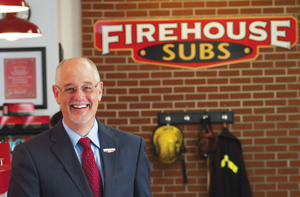Restaurant rents, which had eased significantly during the Great Recession, have been rising in the past year and a half, and are beginning to put pressure on the industry’s bottom line.
While many parts of the nation are seeing retail rent pressures, one of the more celebrated cases was the June announcement by New York City-based Union Square Hospitality Group that the storied Union Square Cafe would likely move after nearly 30 years in the same location because of lease increases.
“Things have changed in New York, which is great news, except perhaps for our restaurant’s lease,” wrote Danny Meyer, chief executive of USHG, in explaining his decision in an op-ed in The New York Times. “Union Square Cafe’s second 15-year lease will expire at the end of December 2015, and unless we’re able to complete a Hail Mary pass with our landlord before that point, we will have to move.”
RELATED
• Lease negotiation for a healthy business
• Know your leasing options
• More restaurant operations news

Meyer, whose personal assistant said Thursday he was spending time with his family and would have nothing to add beyond the Times piece, said the Union Square Cafe story had neither victims nor villains.
“But as a city, we’ve got a problem,” Meyer said. “Because the market suggests they can, landlords are using this moment to demand the significantly higher rents they’ve been waiting for since first betting on their neighborhoods. In our case, the advertised rent is triple what we are now paying.”
And Union Square Cafe is not alone. Restaurant operators are generally seeing lease terms escalate to pricier levels as the economy improves.
Don Fox, chief executive of 793-unit Firehouse Subs, based in Jacksonville, Fla., said, “Certainly coming out of the recession, and all the pain that caused among lessees and lessors, there were many workouts to keep spaces from going vacant. A positive that emerged was a better understanding between landlords and their tenants in regard to the business models.”
Landlords considered rent relief and tenants became transparent with those landlords, Fox said. “Once the dust settled on the recession, that was positive,” he said. “Landlords had a better understanding of their tenants, and we didn’t have much rent escalation.”
But as restaurants are growing again, they face a more limited supply of locations that are driving rent up, said Fox, whose own company plans to add more than 60 locations between now and the end of year.
Research firms are seeing the commercial real estate market tighten as well. Los Angeles-based real estate and investment firm CBRE Group Inc. issued a retail market report July 7 that found second-quarter retail availability rates dropped 20 basis points, to 11.7 percent. That puts retail availability rates 150 basis points below the recession peak of 13.2 percent, the company said.
Significant (more than 60 basis points) declines in second-quarter availability from the first quarter were noted in Tampa, Fla.; Philadelphia; and Raleigh and Charlotte, N.C. Rising availability was seen in Cleveland, Ohio, St. Louis and Salt Lake City, CBRE said. The firm also foresees availability rates declining to 11 percent in neighborhood and community shopping centers.
On a year-over-year basis, CBRE found retail real estate markets tightening markets in Houston and Fort Worth, Texas; Tampa, Fla.; and Atlanta.
“Since the Great Recession, the coastal U.S. cities — both on the West and East Coasts and parts of Florida — have seen a resurgence in rents,” Jim Haslem, real estate consultant with the Roseville, Calif.-based Huntley, Mullaney, Spargo & Sullivan Inc. “In some cases, it has been quite pronounced. The higher rents are often found in the metropolitan coastal cities: San Francisco, Los Angeles, New York and Boston.”
Haslem added that brick-and-mortar retailing is under a significant pressure from the Internet, especially for some big-box retailers like bookstores and electronics brands.
“In the restaurant world, we’re seeing the effects of those pressures,” Haslem added. “The Internet has created applications and products that are intruding into the normal operations of a restaurant. And restaurants are impacted by the rents of their neighbors. If you are in a shopping mall with low vacancies, you’ll pay higher rents. Distressed malls would be more negotiable.”
Haslem said that as brick-and-mortar retailers downsize, it produces a structural change for restaurant tenants.
“Restaurants are in the same ecosystem,” he said. “The stratification between the top sites and the less than top sites may have a wider disparity these days.”
Also, as the economy normalizes, there is less bargaining power for the restaurant operator seeking the top sites, Haslem said.
Negotiating a lease

(Continued from page 1)
In lease negotiations, Haslem recommends operators look at the rent, the rent escalations, the lease term and the options to renew.
“What is often overlooked by restaurant operators is that the rent is among the top three costs in the restaurant profit-loss statement with cost of goods sold and labor,” he said. “Often, rent is No. 2 on that list.
“In good times or bad times, you have to pay the rent,” he said. “In the work that we’ve done in a bankruptcy context with those companies that have filed for Chapter 11, we’ve analyzed the locations that have failed.
“Rent is a highly determinative factor between success and failure,” Haslem added. “A restaurant can be doing everything right — the menu, the food, the service, the marketing, the following are all dialed in — but if the rent is not right for that restaurant, it can be the main reason the restaurant fails or put the restaurant at a high risk of failure. It’s often overlooked.”
Fox of Firehouse Subs said the recession led to a reduction and sometimes halt in commercial retail construction, which is now coming home to roost for those brands wanting to expand as the economy improves.
“That reduction in inventory has put some pressures on availability,” Fox said. “The normal change in supply and demand puts pressure on rents.
“Over the past year and a half, we’ve seen the pendulum start to swing to the landlords’ side,” he added. “They’ve become more aggressive in an increasing number of markets. The number of brands that are back on track financially and back to expanding is starting to outpace availability.”
Fox said the move is now similar to pre-recession “but not quite as crazy.”
The most significant increases are being seen in the major metropolitan areas, Fox added.
“We really don’t want to see our rents creep up above 8 or 8.5 percent of sales,” Fox said. “Once you get beyond that point, you are very hard-pressed to find those points on the P&L.”
Consultant Haslem agreed.
“People when they are looking at a location, for retail or restaurant, think they need to ask, ‘Am I paying a market rent?’ But market rents are subjective,” he said.
“The more germane question is: What is the right rent that this restaurant can bear at this particular location?” he suggested. “If you have a portfolio of restaurants or multiple locations, you can sift through those leases and compare the occupancy costs as compare with sales. Look at the profitability of those locations. You should then be able to develop what I call the target metric for the concept.”
That target, he added, will vary by segment.
Fox said lease negotiations can include tenant improvement money, which would be figured in to the lease terms, but that some landlords are less likely consider that in post-recession negotiations.
“What’s most critical for success is having that great relationship between the landlord and the tenant,” Fox reiterated. “If they have a fundamental understanding of each others business, it is a symbiotic relationship. That was a lesson learned from the recession. We should make sure that’s not forgotten.”
Haslem noted that some restaurant concepts are especially at a disadvantage in lease negotiations if their name is specific to a location.
“Union Square Cafe, which is a fantastic restaurant, and Danny Meyer, who is a fantastic operator, face a challenge,” he said. “It’s a storied restaurant that is in a storied location, which creates a difficulty if you have your restaurant associated with a particular location. That adds risk if you have to relocate.”
Contact Ron Ruggless at [email protected].
Follow him on Twitter: @RonRuggless

